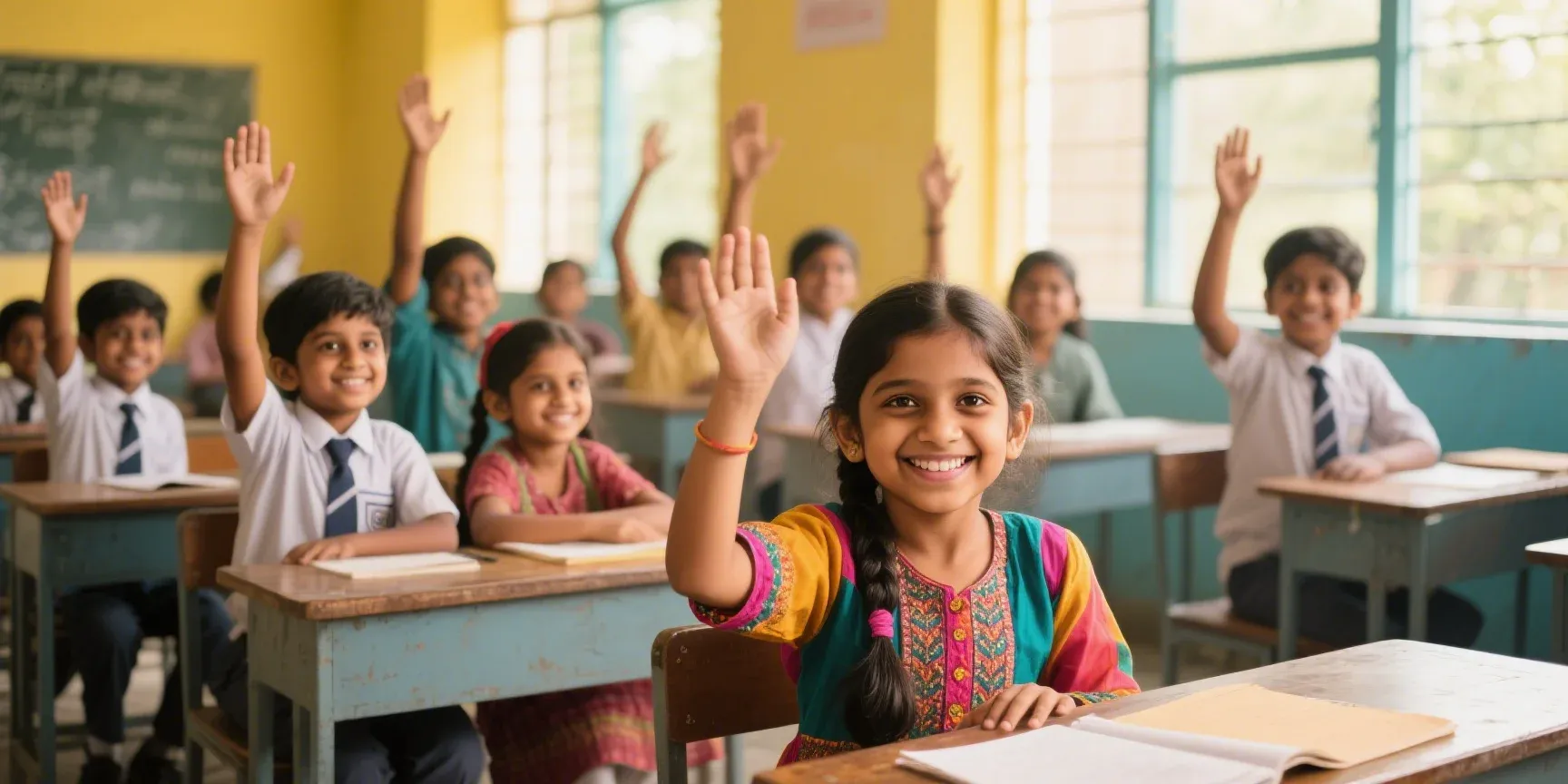
The RTE Act 2009: A Comprehensive Guide to the Right to Education in India
Unlock the story of India's silent education revolution: a deep dive into the landmark RTE Act, 2009, which turned schooling into a fundamental right, forced private schools to open their gates, and sparked fierce court battles that continue to shape the future of millions of children.
The Right of Children to Free and Compulsory Education Act, 2009, popularly known as the RTE Act, stands as a monumental piece of legislation in the history of Indian education. Enacted on August 26, 2009, and brought into force on April 1, 2010, this Act operationalized the fundamental right to education for millions of children across the nation. This article delves deep into the nuances of the RTE Act, its objectives, key provisions, historical context, and the landmark judicial pronouncements that have shaped its trajectory.
The Genesis of the Right to Education: A Historical Perspective
The journey to make education a fundamental right in India was a long and arduous one, marked by constitutional debates, judicial interventions, and legislative action.
Constitutional Foundation and the 86th Amendment
At the time of its adoption in 1950, the Constitution of India included Article 45 as a Directive Principle of State Policy, which stated that the state should endeavor to provide free and compulsory education for all children until they complete the age of fourteen years, within a decade. However, being a directive principle, this was not legally enforceable in courts.
A significant turning point came with the 86th Constitutional Amendment Act of 2002. This amendment inserted Article 21A into the Constitution, elevating the right to education to the status of a fundamental right. Article 21A mandates that “The State shall provide free and compulsory education to all children of the age of six to fourteen years in such manner as the State may, by law, determine.”
This constitutional amendment laid the groundwork for a rights-based framework for education, making it a legal obligation for the Central and State Governments to ensure that every child in the specified age group receives elementary education. The RTE Act, 2009, is the consequential legislation that was enacted to give effect to this fundamental right.
The Role of the Judiciary in Shaping the Right to Education
Even before the 86th Amendment, the Indian judiciary played a proactive role in recognizing the right to education as an integral part of the fundamental right to life under Article 21 of the Constitution.
Mohini Jain v. State of Karnataka (1992): This was a landmark case where the Supreme Court held that the right to education is a fundamental right. The Court declared that the charging of “capitation fees” for admission to educational institutions amounted to a denial of this right and was a violation of Article 14 (Right to Equality). It emphatically stated that education is not a commodity to be sold.
Unni Krishnan, J.P. v. State of Andhra Pradesh (1993): While reaffirming that the right to education flows from Article 21, this judgment partially overruled the Mohini Jain case. It clarified that the right to free education is available only to children until they complete the age of 14. Beyond this age, the State’s obligation is subject to its economic capacity. The Court also permitted private unaided educational institutions to charge higher fees than government institutions, but these fees should not be exorbitant and should be regulated by the State. This case was instrumental in prompting the constitutional amendment that led to Article 21A.
What is the RTE Act 2009? Understanding its Full Form and Core Mandate
The full form of the RTE Act is The Right of Children to Free and Compulsory Education Act, 2009. As the name suggests, the Act’s primary mandate is to ensure that every child between the ages of six and fourteen years receives free and compulsory elementary education.
“Free Education” under the Act means that no child shall be liable to pay any kind of fee or charges or expenses which may prevent them from pursuing and completing elementary education. This includes not just tuition fees but also encompasses essentials like textbooks, uniforms, and stationery.
“Compulsory Education” casts a binding obligation on the appropriate government and local authorities to provide and ensure admission, attendance, and completion of elementary education for every child in the 6-14 age group. This makes the government accountable for ensuring universal enrollment and retention in schools.
Objectives of the RTE Act, 2009: A Multi-faceted Approach
The objectives of the RTE Act are not merely confined to providing access to schools. It aims to bring about a qualitative and equitable transformation in the elementary education system. The key objectives include:
- Universal Access and Enrollment: To ensure that every child between the ages of 6 and 14 is enrolled in a school and completes their elementary education.
- Equity and Social Inclusion: To bridge social gaps in education by ensuring that children from all sections of society, including weaker sections and disadvantaged groups, have access to quality education.
- Quality Education: To lay down norms and standards for schools to ensure a minimum quality of education for all children.
- Child-Friendly and Non-Threatening Environment: To create a learning environment that is free from fear, trauma, and anxiety for every child.
- Holistic Development: To develop a curriculum that contributes to the all-round development of the child, building on their knowledge, potential, and talent.
- Accountability of Stakeholders: To define and enforce the duties and responsibilities of the government, local authorities, schools, teachers, and parents in providing education.
Key Sections of the RTE Act, 2009: A Detailed Analysis
The RTE Act is a comprehensive piece of legislation with several crucial sections that outline the framework for achieving its objectives.
Section 3: The Right of the Child
This section is the cornerstone of the Act. It explicitly states that every child between six and fourteen years has a right to free and compulsory education in a neighborhood school until the completion of their elementary education. It further clarifies that no child is liable to pay any fee or charge that could hinder their elementary education.
Section 4: Mainstreaming Out-of-School Children
This provision is designed to bring out-of-school children into the educational mainstream. It mandates that a child above the age of six who has not been admitted to a school or has dropped out should be admitted to a class appropriate to their age. Such children are also entitled to special training to help them catch up with their peers. They remain entitled to free education even after the age of fourteen if they have not completed their elementary education.
Section 6: Duty to Establish Schools
To ensure accessibility, this section places a duty on the appropriate government and local authorities to establish schools within specified neighborhood limits. This is to be done within three years of the Act’s commencement where such schools do not already exist.
Section 12(1)(c): The 25% Reservation Mandate
This is one of the most significant and debated provisions of the RTE Act. It mandates that private unaided schools and specified category schools must admit at least 25% of their strength in Class I to children belonging to weaker sections and disadvantaged groups from the neighborhood. These schools are required to provide free and compulsory elementary education to these children. The state is obligated to reimburse the expenditure incurred by these schools for such admissions.
Section 13: Prohibition of Capitation Fee and Screening
This section prohibits any school or person from collecting a capitation fee or subjecting a child or their parents/guardians to any screening procedure for admission. This is aimed at preventing discrimination and commercialization of education. Any form of interview or test for admission is considered a screening procedure and is illegal.
Section 16: The ‘No-Detention’ Policy and its Amendment
Originally, this section stipulated a “no-detention” policy, meaning no child could be held back in any class or expelled from school until the completion of elementary education. The rationale was to reduce pressure and dropout rates.
However, this policy faced criticism for potentially leading to a decline in learning outcomes. Consequently, the Right of Children to Free and Compulsory Education (Amendment) Act, 2019, was passed, eliminating the no-detention policy. This amendment allows for regular examinations in the fifth and eighth grades. It gives states the discretion to allow schools to hold back a child if they fail a re-examination, while still prohibiting expulsion.
Section 17: Prohibition of Physical Punishment and Mental Harassment
This section is crucial for creating a positive and safe learning environment. It strictly prohibits subjecting any child to physical punishment or mental harassment. Violators of this provision are liable for disciplinary action.
Section 23: Teacher Qualifications
To ensure quality education, this section outlines the minimum qualifications for the appointment of teachers, which are to be laid down by an academic authority authorized by the Central Government. It also provides for a grace period for existing teachers to acquire the prescribed qualifications.
Landmark Judgments Interpreting the RTE Act
The judiciary has continued to play a vital role in interpreting and clarifying the provisions of the RTE Act since its enactment.
Society for Un-aided Private Schools of Rajasthan v. Union of India (2012): In this significant case, the Supreme Court upheld the constitutional validity of Section 12(1)(c) of the RTE Act, which mandates the 25% reservation for children from weaker sections in private unaided schools. The Court held that this provision is a reasonable restriction on the right of private schools to carry on an occupation under Article 19(1)(g) of the Constitution, aimed at achieving the constitutional goals of equality and social justice.
Pramati Educational & Cultural Trust v. Union of India (2014): This judgment clarified the applicability of the RTE Act to minority educational institutions. The Supreme Court held that the RTE Act, particularly the 25% reservation under Section 12(1)(c), is not applicable to minority schools, whether aided or unaided. The Court reasoned that forcing such a reservation on minority institutions would infringe upon their right to establish and administer educational institutions of their choice, as guaranteed under Article 30(1) of the Constitution.
Implementation of the RTE Act: Successes and Challenges
The RTE Act was implemented across India on April 1, 2010. On this day, India joined a select group of 135 countries where education is a fundamental right of every child. The then Prime Minister, Manmohan Singh, announced the implementation in a historic speech, emphasizing the government’s commitment to ensuring education for all children, irrespective of gender or social category.
Successes of the RTE Act
The implementation of the RTE Act has led to several positive outcomes:
- Increased Enrollment: There has been a significant increase in enrollment rates, especially at the upper primary level. The Act has been successful in bringing more children into the formal schooling system.
- Improved Infrastructure: The Act has led to an increased focus on improving school infrastructure, including the construction of more classrooms, toilets, and the provision of drinking water facilities.
- Enhanced Social Inclusion: The 25% reservation in private schools has provided opportunities for children from economically weaker and disadvantaged sections to access quality education, thereby promoting social integration.
- Reduced Dropout Rates: The initial no-detention policy contributed to a reduction in dropout rates by ensuring that children could complete their elementary education without the fear of failure.
Challenges in Implementation
Despite its successes, the implementation of the RTE Act has been fraught with challenges:
- Inadequate Infrastructure: Many schools, particularly in rural areas, still lack basic infrastructure, which affects the quality of the learning environment.
- Teacher Shortage and Quality: A shortage of qualified and trained teachers remains a significant hurdle. The quality of teacher education and their professional development also needs substantial improvement.
- Non-Compliance by Private Schools: Many private schools have been reluctant to comply with the 25% reservation mandate, and there are often delays in the reimbursement of fees by the government.
- Socio-economic Barriers: Poverty, child labor, and discriminatory social norms continue to prevent many children from accessing and completing their education.
- Learning Outcomes: While enrollment has increased, the focus on learning outcomes has often been inadequate, leading to concerns about the quality of education being imparted.
- Financial Constraints: The financial allocation for the implementation of the Act has often been insufficient to meet all the requirements.
- Exclusion of Early Childhood Education: A major limitation of the Act is that it does not cover the crucial early childhood years (0-6 years), which are vital for a child’s development.
The Way Forward: Strengthening the Right to Education
The RTE Act, 2009, is a transformative piece of legislation that has fundamentally altered the educational landscape of India. It has successfully established a legal framework to ensure that every child’s right to education is not just a policy goal but a justiciable right.
However, the journey towards universal, equitable, and quality elementary education is far from over. Addressing the persistent challenges in implementation requires a concerted effort from all stakeholders. This includes increased and timely allocation of financial resources, a renewed focus on improving the quality of teaching and learning, stringent monitoring of the Act’s provisions, and greater community involvement.
By building on the successes of the RTE Act and tackling its shortcomings head-on, India can move closer to realizing the constitutional promise of an enlightened and empowered citizenry, where every child has the opportunity to reach their full potential.
Frequently Asked Questions (FAQ) about the RTE Act, 2009
Here are answers to some of the most common questions about the Right to Education Act.
1. What is the full form of the RTE Act?
The full form is The Right of Children to Free and Compulsory Education Act, 2009.
2. What is the main objective of the RTE Act?
The primary objective is to provide free and compulsory elementary education to every child in India. It aims to ensure all children have access to quality education without discrimination.
3. Which age group is covered by the RTE Act?
The Act covers children between the ages of 6 and 14 years.
4. When did the RTE Act come into effect?
The RTE Act was enacted on August 26, 2009, and came into force across India on April 1, 2010.
5. What does “free education” under the RTE Act actually mean?
“Free education” means that no child is required to pay any fee or expense that could prevent them from completing elementary education. This goes beyond just tuition fees and includes costs for textbooks, uniforms, and other essential learning materials.
6. What is the 25% reservation rule for private schools?
Section 12(1)(c) of the Act mandates that all private unaided schools (except minority institutions) must reserve at least 25% of seats in their entry-level class (like Class 1 or pre-primary) for children from economically weaker sections (EWS) and disadvantaged groups. The government is supposed to reimburse the schools for the expenses of these students.
7. Are all schools in India bound by the RTE Act?
Most schools are, but there are exceptions. The RTE Act does not apply to minority educational institutions (both religious and linguistic) and institutions imparting primarily religious instruction, like Madrasas and Vedic Pathshalas.
8. Can a school conduct an admission test or interview a child/parent?
No. Section 13 of the RTE Act strictly prohibits any screening procedure, which includes admission tests or interviews for either the child or their parents. Admissions, especially under the 25% quota, are often done through a random selection or lottery system.
9. Is the “no-detention policy” still in effect?
No. The original provision in the Act that prevented schools from holding back any child in a class up to the 8th grade was amended in 2019. States now have the authority to hold regular exams in Classes 5 and 8 and can detain a student if they fail the re-examination. However, no child can be expelled from school.
10. What can a parent do if a school violates the RTE Act?
A parent can file a written complaint with the designated local authority. The Act also provides for a grievance redressal mechanism through the State Commissions for the Protection of Child Rights (SCPCR) or the National Commission for the Protection of Child Rights (NCPCR), which can investigate complaints. Some states have also set up specific grievance redressal committees at the taluka, district, and state levels.


